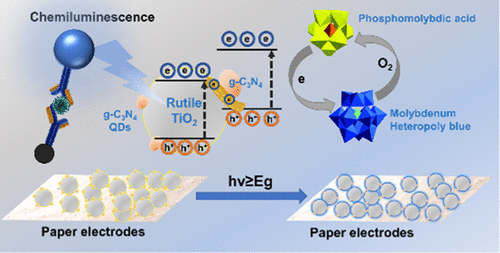当前位置:
X-MOL 学术
›
Anal. Chem.
›
论文详情
Our official English website, www.x-mol.net, welcomes your
feedback! (Note: you will need to create a separate account there.)
Chemiluminescence-Derived Self-Powered Photoelectrochemical Immunoassay for Detecting a Low-Abundance Disease-Related Protein
Analytical Chemistry ( IF 6.7 ) Pub Date : 2021-09-23 , DOI: 10.1021/acs.analchem.1c03344 Zhichao Yu 1 , Hexiang Gong 1 , Yuxuan Li 1 , Jianhui Xu 1 , Jin Zhang 2 , Yongyi Zeng 3 , Xiaolong Liu 3 , Dianping Tang 1, 2
Analytical Chemistry ( IF 6.7 ) Pub Date : 2021-09-23 , DOI: 10.1021/acs.analchem.1c03344 Zhichao Yu 1 , Hexiang Gong 1 , Yuxuan Li 1 , Jianhui Xu 1 , Jin Zhang 2 , Yongyi Zeng 3 , Xiaolong Liu 3 , Dianping Tang 1, 2
Affiliation

|
Early diagnosis of cancers relies on the sensitive detection of specific biomarkers, but most of the current testing methods are inaccessible to home healthcare due to cumbersome steps, prolonged testing time, and utilization of toxic and hazardous substances. Herein, we developed a portable self-powered photoelectrochemical (PEC) sensing platform for rapid detection of prostate-specific antigen (PSA, as a model disease-related protein) by integrating a self-powered photoelectric signal output system catalyzed with chemiluminescence-functionalized Au nanoparticles (AuNPs) and a phosphomolybdic acid (PMA)-based photochromic visualization platform. TiO2-g-C3N4-PMA photosensitive materials were first synthesized and functionalized on a sensor chip. The sensor consisted of filter paper modified with a photocatalytic material and a regional laser-etched FTO electrode as an alternative to a conventional PEC sensor with a glass-based electrode. The targeting system involved a monoclonal anti-PSA capture antibody-functionalized Fe3O4 magnetic bead (mAb1-MB) and a polyclonal anti-PSA antibody (pAb2)-N-(4-aminobutyl)-N-ethylisoluminol-AuNP (ABEI-AuNP). Based on the signal intensity of the chemiluminescent system, the photochromic device color changed from light yellow to heteropoly blue through the PMA photoelectric materials integrated into the electrode for visualization of the signal output. In addition, the electrical signal in the PEC system was amplified by a sandwich-type capacitor and readout on a handheld digital multimeter. Under optimum conditions, the sensor exhibited high sensitivity relative to PSA in the range of 0.01–50 ng mL–1 with a low detection limit of 6.25 pg mL–1. The flow-through chemiluminescence reactor with a semiautomatic injection device and magnetic separation was avoid of unstable light source intensity inherent in the chemiluminescence process. Therefore, our strategy provides a new horizon for point-of-care analysis and rapid cost-effective clinical diagnosis.
中文翻译:

用于检测低丰度疾病相关蛋白质的化学发光衍生自供电光电化学免疫分析
癌症的早期诊断依赖于对特定生物标志物的灵敏检测,但由于步骤繁琐、检测时间过长以及有毒有害物质的使用,目前大多数检测方法无法用于家庭医疗保健。在此,我们开发了一种便携式自供电光电化学(PEC)传感平台,通过集成化学发光功能化金催化的自供电光电信号输出系统,快速检测前列腺特异性抗原(PSA,作为一种模型疾病相关蛋白)。纳米粒子 (AuNPs) 和基于磷钼酸 (PMA) 的光致变色可视化平台。TiO 2 -gC 3 N 4-PMA 光敏材料首先在传感器芯片上合成和功能化。该传感器由用光催化材料改性的滤纸和区域激光蚀刻 FTO 电极组成,作为具有玻璃基电极的传统 PEC 传感器的替代品。靶向系统包括单克隆抗 PSA 捕获抗体功能化的 Fe 3 O 4磁珠 (mAb 1 -MB) 和多克隆抗 PSA 抗体 (pAb 2 )- N -(4-氨基丁基)- N-乙基异鲁米诺-AuNP (ABEI-AuNP)。基于化学发光系统的信号强度,光致变色器件颜色通过集成到电极中的PMA光电材料从浅黄色变为杂多蓝色,用于信号输出的可视化。此外,PEC 系统中的电信号由夹心型电容器放大,并在手持数字万用表上读出。在最佳条件下,传感器在 0.01–50 ng mL –1范围内表现出相对于 PSA 的高灵敏度,低检测限为 6.25 pg mL –1. 带有半自动注入装置和磁分离的流通式化学发光反应器避免了化学发光过程中固有的不稳定光源强度。因此,我们的策略为床旁分析和快速具有成本效益的临床诊断提供了新的视野。
更新日期:2021-10-06
中文翻译:

用于检测低丰度疾病相关蛋白质的化学发光衍生自供电光电化学免疫分析
癌症的早期诊断依赖于对特定生物标志物的灵敏检测,但由于步骤繁琐、检测时间过长以及有毒有害物质的使用,目前大多数检测方法无法用于家庭医疗保健。在此,我们开发了一种便携式自供电光电化学(PEC)传感平台,通过集成化学发光功能化金催化的自供电光电信号输出系统,快速检测前列腺特异性抗原(PSA,作为一种模型疾病相关蛋白)。纳米粒子 (AuNPs) 和基于磷钼酸 (PMA) 的光致变色可视化平台。TiO 2 -gC 3 N 4-PMA 光敏材料首先在传感器芯片上合成和功能化。该传感器由用光催化材料改性的滤纸和区域激光蚀刻 FTO 电极组成,作为具有玻璃基电极的传统 PEC 传感器的替代品。靶向系统包括单克隆抗 PSA 捕获抗体功能化的 Fe 3 O 4磁珠 (mAb 1 -MB) 和多克隆抗 PSA 抗体 (pAb 2 )- N -(4-氨基丁基)- N-乙基异鲁米诺-AuNP (ABEI-AuNP)。基于化学发光系统的信号强度,光致变色器件颜色通过集成到电极中的PMA光电材料从浅黄色变为杂多蓝色,用于信号输出的可视化。此外,PEC 系统中的电信号由夹心型电容器放大,并在手持数字万用表上读出。在最佳条件下,传感器在 0.01–50 ng mL –1范围内表现出相对于 PSA 的高灵敏度,低检测限为 6.25 pg mL –1. 带有半自动注入装置和磁分离的流通式化学发光反应器避免了化学发光过程中固有的不稳定光源强度。因此,我们的策略为床旁分析和快速具有成本效益的临床诊断提供了新的视野。











































 京公网安备 11010802027423号
京公网安备 11010802027423号